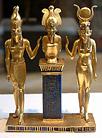Egypt
One of the first known kings, or pharaohs, of ancient Egypt was named Narmer, and he ruled in the thirty-first century BCE. We know his name from a famous artifact called the Narmer Palette, which depicts the king on one side with the White Crown of Upper Egypt and on the other side with the Red Crown of Lower Egypt, illustrating the unification of Egypt into one nation. Unlike the slow development of kingship in Mesopotamia, the concept of kingship in Egypt remained basically the same throughout the country’s history. And, also unlike ancient Mesopotamia, where foreign groups were able to settle peacefully and eventually to become rulers, foreigners, who were viewed as intruders, ruled Egypt only briefly.
Royal Ideology
The Egyptian king was an absolute ruler. As in Mesopotamia, kingship in Egypt was believed to have been given to mortals by the gods; therefore, the authority of the king was not to be questioned. He was believed to be the embodiment of the god Horus (a falcon-headed solar god). In death, the king was thought to become Osiris, the lord of the dead. Because, according to myths, Horus was the son of Osiris, each king succeeded his father in an unbroken line of descent, regardless of their actual biological relationship.
Beginning with the first dynasties, kings began to build monumental mortuary structures for themselves, both to demonstrate their power and to ensure their passage to the afterlife. The ability to commission such massive building projects and have the plans carried out attests to the great authority of the king, as well as to the existence of a complex bureaucracy. The first examples of these monumental tombs were built in Abydos, in southern Egypt, where the earliest evidence of Egyptian writing was found. Zoser (ca. 2737-2717 BCE), the second ruler of the Third Dynasty during the Old Kingdom (ca. 2755-2255 BCE), continued this tradition, commissioning the construction of a monumental step pyramid built of limestone blocks at Saqqara, south of Memphis, which was the capital at that time. Zoser’s Step Pyramid was the precursor to the enormous pyramids built by the Fourth Dynasty kings at Giza north of Saqqara. Later, during the New Kingdom (1570-1070 BCE), beginning with Amenhotep I (18th Dynasty), kings were buried in rock-cut tombs hidden in the Valley of Kings near Luxor.
The kings of the Eighteenth Dynasty established their capital in Thebes, in southern Egypt. One result was the rise in importance of the god Amun, as evidenced by the kings’ names, which incorporate the name of that god (e.g., Amenhotep I-IV and Tutankhamun). Interestingly, Amenhotep IV changed his name to Akhenaton to honor Aton, a form of the god Re as the sun disk. Akhenaton’s worship of Aton bordered on monotheism, and he established a new capital that he named Akhetaton at Tell el Amarna. This anomalous period was short-lived as his second successor, King Tutankhamun, returned the capital to Thebes and abandoned Akhenaton’s religious innovations.
Egyptian kings were responsible for protecting their people from foreign invaders and, therefore, were portrayed smiting foreign enemies in the presence of the approving gods. In addition to protecting Egypt, kings also attempted to expand the borders of their land: into Nubia south of the traditional border at Elephantine/Aswan, and northeast into the Levant. Egyptian kings battled at various times with Assyrian and Babylonian kings, as well as Hittite kings from ancient Anatolia (modern Turkey) for control of Syria and Palestine.

 Jennie Myers
Jennie Myers
Research Associate, University of Chicago
Guiding Questions
1. How did the role of the ruler change in Mesopotamia?
2. In what ways were the roles of Egyptian and Mesopotamian rulers similar? What made them distinct?
3. What are some similarities between the justice systems of Egypt and Mesopotamia, and that of the United States?


 Print Page
Print Page

